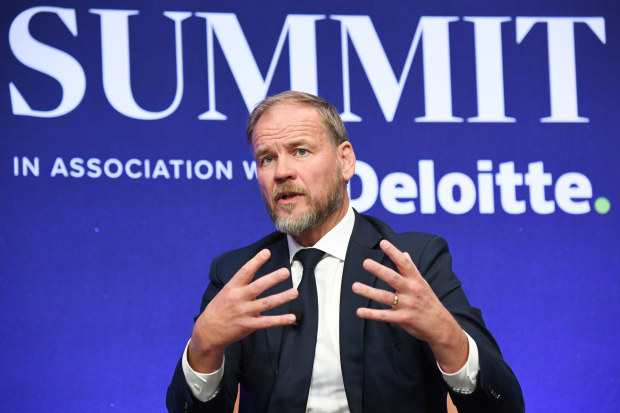Squadron Energy to spend $20b on renewables by 2030

Andrew Forrest’s Squadron Energy will spend as much as $20 billion by 2030 to build out its renewable projects, CEO Jason Willoughby said, illustrating the scale of the company’s ambitions.
Squadron has recently expanded to become Australia’s biggest renewables’ player after its $4.2 billion purchase of CWP Renewables late last year. The purchase was the biggest so far for Andrew and Nicola Forrest’s private investment company, Tattarang, run by John Hartman.

Jason Willoughby, Squadron Energy’s CEO says coal-fired power station needed to be urgently phased out. Peter Rae
“The shareholders have contributed $5 billion dollars into the Squadron business already. So it’s a big investment,” Mr Willoughby told The Australian Financial Review Energy & Climate Summit. “We think the majority of that new capex is funded by debt. And then we’ve got the equity capability to fund the balance.”
Squadron has 1.1 gigawatts of renewable energy generation in operation and a development pipeline of wind and solar of 20 gigawatts. The CWP purchase was funded by Tattarang and Mr Willoughby would not be drawn on whether Squadron would be taking on outside investors to help with its development pipeline.
Squadron reported a $220.3 million loss, from a $45 million loss one year earlier, although the majority of expenses were related to the acquisition of CWP from Partners Group in December. Earnings before interest, tax, depreciation, amortisation and fair value movements were $41.3 million.
Dr Forrest and Fortescue have been increasingly outspoken on climate change. Mr Willoughby warned that keeping coal-fired power stations going will be economically damaging for the country especially considering record hot temperatures globally.
“Last year we saw really historic, wholesale electricity prices really driven by unplanned coal outages. That risk hasn’t gone away,” said Mr Willoughby. “We’re still on 60-something per cent of our generation coming from old, aged coal plants. We need to transition, and we need to replace those coal plants as soon as possible.”
Squadron has also invested in developing a LNG import terminal in Port Kembla in NSW, which it hopes to use by 2026 when it expects there to be a domestic supply shortfall.
“We don’t think that the terminal is contradictory to the focus on reducing fossil fuels,” Mr Willoughby said. “By having the terminal being able to bring gas in from other existing fields into a market [where there is a] shortfall, we think that means that we don’t have to build out new gas fields.”
Mr Willoughby said it expects the terminal’s construction to be completed by the end of 2024. Squadron would only be a minority user, with the company hoping it can find other partners to take up the rest of the supply.
Introducing your Newsfeed
Follow the topics, people and companies that matter to you.
Find out moreRead More
Latest In Energy
Fetching latest articles